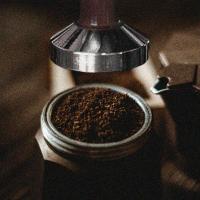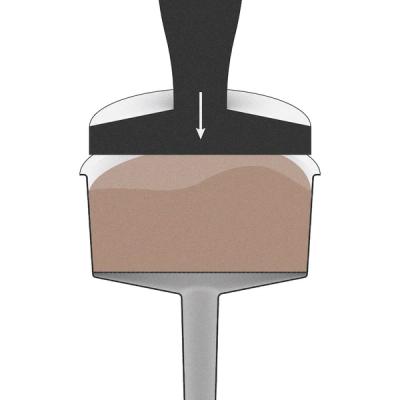Should you tamp grounds in a moka pot?
No, you shouldn't tamp the coffee in a moka pot. Compressing the coffee can create an unwanted burnt taste, and in the worst case scenario, cause your moka pot to explode.

Table of contents
Moka pots are often described as stove-top espresso makers, and so understandably people believe they should tamp the grounds, as you would for an espresso machine. But except under very specific nerdy circumstances this is probably the wrong thing to do.
If you want to get your moka pot coffee closer to an espresso — with more crema and a richer flavour — it's more effective to decrease the grind size or use a darker roast.
A quick warning about exploding moka pots
Under certain circumstances a moka pot can explode — resulting in coffee everywhere and possible injury.
To avoid an explosion make sure of three things:
- The safety valve is not clogged
- Never use a fine, espresso like grind in a moka pot
- Never fill the lower-chamber higher than the safety valve
Tamping the grounds will increase the pressure in your moka pot. In combination with a clogged safety valve, over filled lower chamber, and too fine a grind this will increase the chances of an explosion.

Moka pots
How does a moka pot work?
What does tamping the grounds do?
Tamping the grounds creates more pressure in the moka pot, increases the time it takes the coffee to brew, and can result in unwanted flavours.
Channeling and uneven extraction
Compressing coffee can result in both under-extraction, leading to watery coffee, and over-extraction, resulting in astringent flavors. This is caused by channeling.
Channeling occurs in tamped coffee when water finds an easier path through one section of the puck—the compressed cylinder of coffee—than through others, creating a channel.
How channeling happens in a moka pot?
When you compress a heap of coffee grounds, the areas with greater height will become more densely packed.


Water will naturally take the path of least resistance, flowing through the less dense areas and avoiding the more densely packed areas.

The primary issue with channeling is under-extraction, which leads to a lack of flavour and watery coffee.
However, channeling can cause over-extraction, pulling unwanted flavours from the the areas water flows through.
Burnt coffee
Burnt coffee tastes bad. The longer it takes for your moka pot to brew, the more the funnel gets hot, which denatures your coffee — coffee residue that was left over from previous brews burns too.
Even a small amount of burnt coffee can cause a nasty taste.
Slightly more crema
Creating more pressure in your moka pot will increase the amount of crema. Crema is created when carbon dioxide from the coffee is dissolved into water at higher pressures.
If your aim is to create more crema, using a finer grind size, or a darker roast is more effective than tamping.
How to get a moka pot to make coffee more like an espresso machine.
Use a finer grind
Using a finer grind, but not too much finer, will give you more crema, and create a flavour closer to an espresso. We've written an in depth article on moka pot grind sizes with a tool to help you find the correct settings for your moka pot.
Use a darker roast
Darker roasts have more espresso like flavours — we've written a article on the best coffee for moka pots. You can use that to help you identify the kind of roast you like.